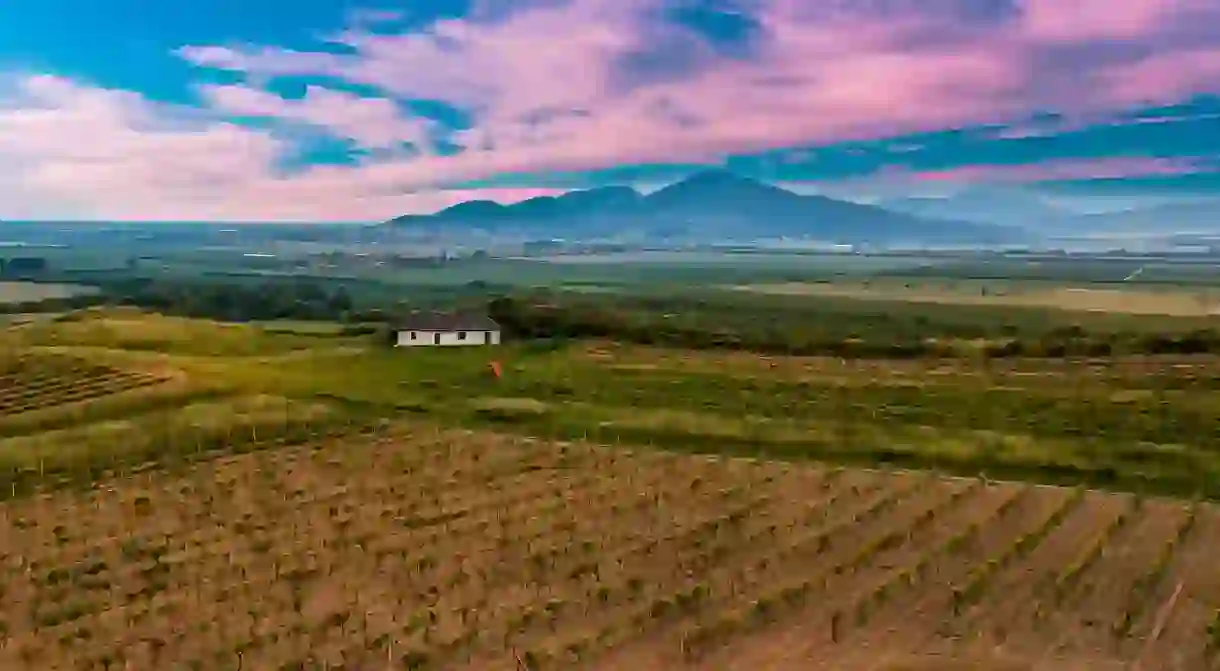A Guide to Exploring Slovakia's 6 Wine Regions

Slovakia‘s nearby countries might be famous for their wine – notably Croatia, with more than 100 medals for the first time ever at the 2017 Decanter World Wine Awards – but Slovakia still boasts six unique wine regions worth every wine lover’s attention. Here’s your ultimate guide.
Malokarpatská, or the “Lesser Carpathian wine region”
The Lesser Carpathian wine region is located in southwestern Slovakia, in the foothill of the Carpathian mountains near Bratislava. The history of growing vines in the region dates back 3,000 years, and both red, white, and rosés are produced in this area. The winemaking towns of Modra and Pezinok, where visitors can select a wine tasting any time of year in one of the local vineyards, also fall within the Lesser Carpathian region. This wine region is the easiest to access for visitors starting in Bratislava. Like all wine regions, visitors will enjoy better access and selection to local vineyards if they elect to rent a car, but arriving via bus to Modra and Pezinok is also possible.
Wine to try: Pereg víno z čiernych ríbezlí, an amazing blackcurrant wine

Južnoslovenská, or the “South Slovak wine region”
Tasting Table labeled the South Slovak wine region as one of the Most Underrated Wine Regions in the World in 2016, due to the high quality wines produced here and the quickly expanding market. Wine production suffered in all Soviet Union countries under Communism, but since then has been making a rapid comeback. You can find the South Slovak wine region just over the Danube River from Hungary, making it easily accessible from either the Budapest or the Bratislava airports. Some of the vineyards here once belonged to the bishop of the Hungarian Basilica of Esztergom, a must see attraction if you decide to visit wineries in this area. You can try some great cabernet sauvignons, but don’t miss out on a Dunaj, a Slovak hybrid blend that you won’t find anywhere else.
Wine to try: Matyas Pince Dunaj, a full-bodied wine similar to pinot noir.
Tokajská, or the “Tokaj wine region”
The Slovak Tokaj wine region is one of the smallest wine regions by size worldwide. Located about a one-hour drive from Kosice, the tiny region is still fairly undiscovered and unspoiled by mass tourism. After a recent New York Times feature, the area is starting to garner more attention, but remains relatively sleepy and laidback. In the small village of Mala Trna, Tokaj Macik Winery has been a family owned and operated business since 1995. Their modern wine blends and traditional Tokaj varieties come in some of the most attractive wine bottles in the industry, earning them awards for their unique label designs. Tokaj Macik Winery even offers an on-site pension, so you can get some rest after tasting each of their lovely Tokaj varieties.
Wine to try: Tokaj Macik Tokajske Vino classic, a sweet, honey-colored wine.

Nitrianska, or the “Nitra wine region”
The Nitra region is well suited for growing grapes thanks to its many sunny days. The Slovak vineyards of the highest elevations are also located in this region. The majority of wine produced in the Nitra region is white varieties such as Veltlinske Zelene, Rizling Vlassky, and Muller-Thurgau. However, some outstanding red wine is also produced here, such as Svatovavrinecke and Frankovka Modra. The stellar Chateau Topoľčianky, one of the most famous vineyards in Central Europe, is located near Nitra. The brand was established in 1933 and today is one of the leading wine producers in the country.
Wine to try: Chateau Topoľčianky Devin Noir, an aromatic, dry, white wine.
Stredoslovenská, or the “Central Slovak wine region”
To the east of the Nitra region and south of Zvolen, the Central Slovak wine region covers the wines produced in the lower central part of the country. About 80% of the wines grown in this region are white, while 20% are reds. The light and easy to drink veltlinske zelene is the most popular type of wine produced in the central Slovak wine region. This wine region continues just across the border in Hungary, leading to the possibility of spending a few days crisscrossing through small towns and villages in southern Slovakia and northern Hungary, tasting the high quality but almost unheard of wines grown in this agricultural region.
Wine to try: Movino veltlinske zelene.

Východoslovenská, or the “East Slovak wine region”
The East Slovak wine region is located slightly south and to the east from Kosice. The soils in this area are mostly from volcanic origin, resulting in a higher concentration of minerals in the soil. This is also the wine region with the second most amount of sun per year. Due to the prime soil and weather conditions, this region is also ideal for late maturing grape varieties. Rizling vlassky is the most popular type of wine to try here, with frankovka modra also earning a good deal of popularity. This is the hardest wine region to get to in Slovakia, as it is quite far from the international airports in Budapest and Bratislava. For this reason, if you head to the East Slovak wine region, don’t be surprised if you have a wine tasting room all to yourself. Start in Kosice, with a wine flight at Koffler Vinoteka to get a better idea of the kind of varieties you will enjoy in the East Slovak wine region. Then, take a drive to pass by the picturesque vineyards of high quality producers such as Fundus Regius, in the far east of Slovakia.
Wine to try: Fundus Regius Frankovka Modra.













